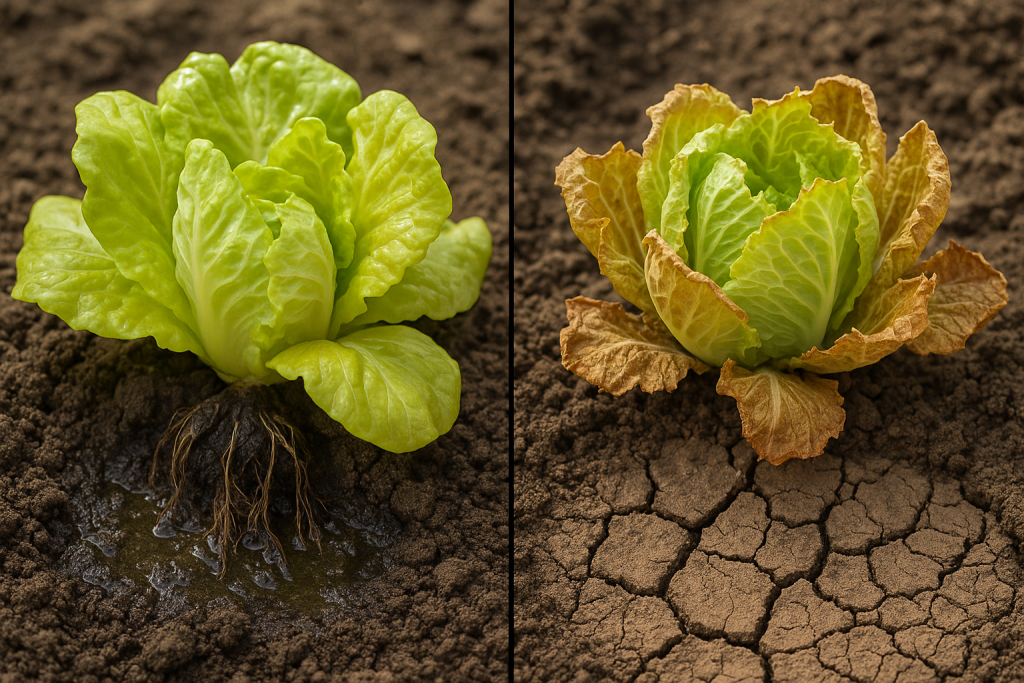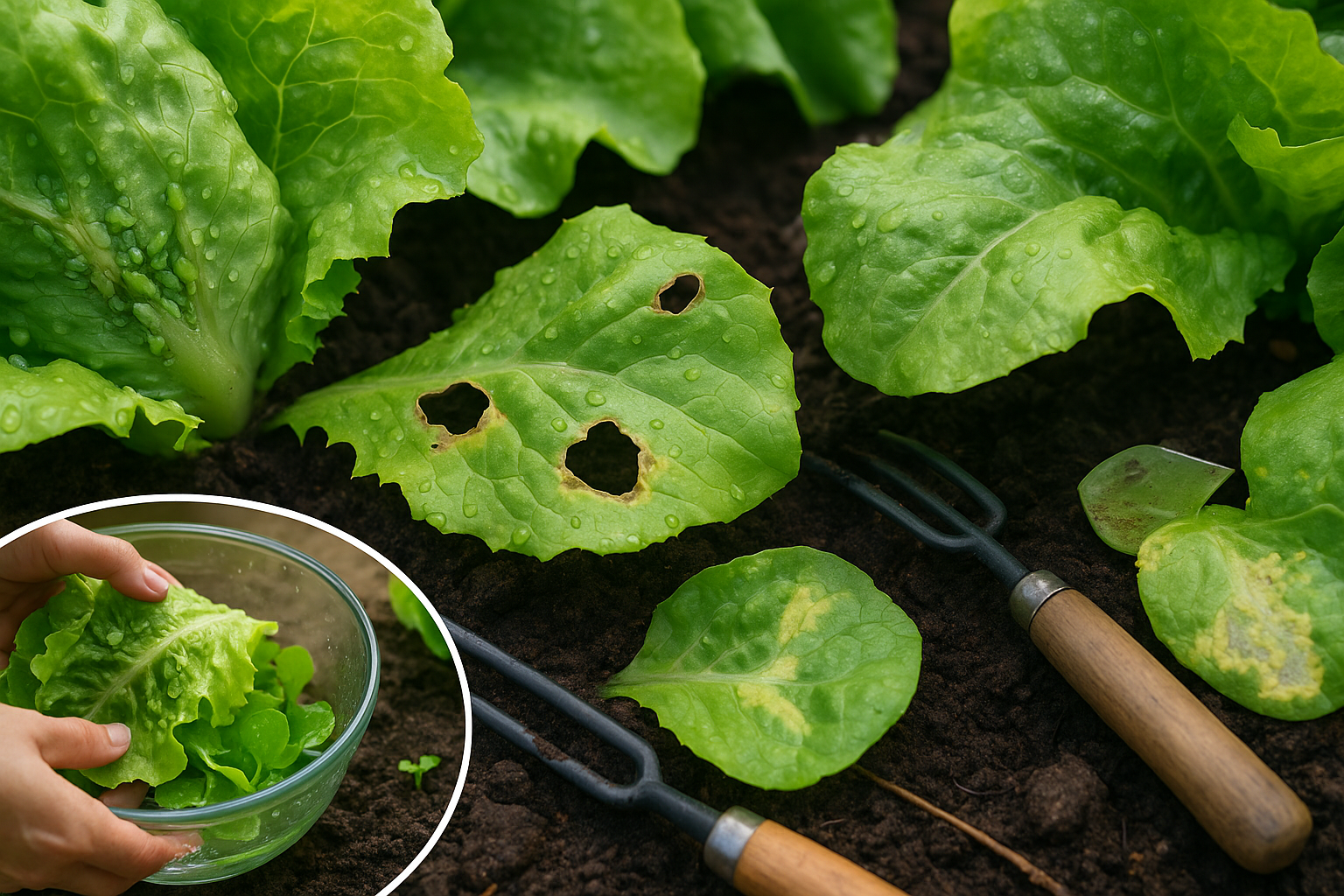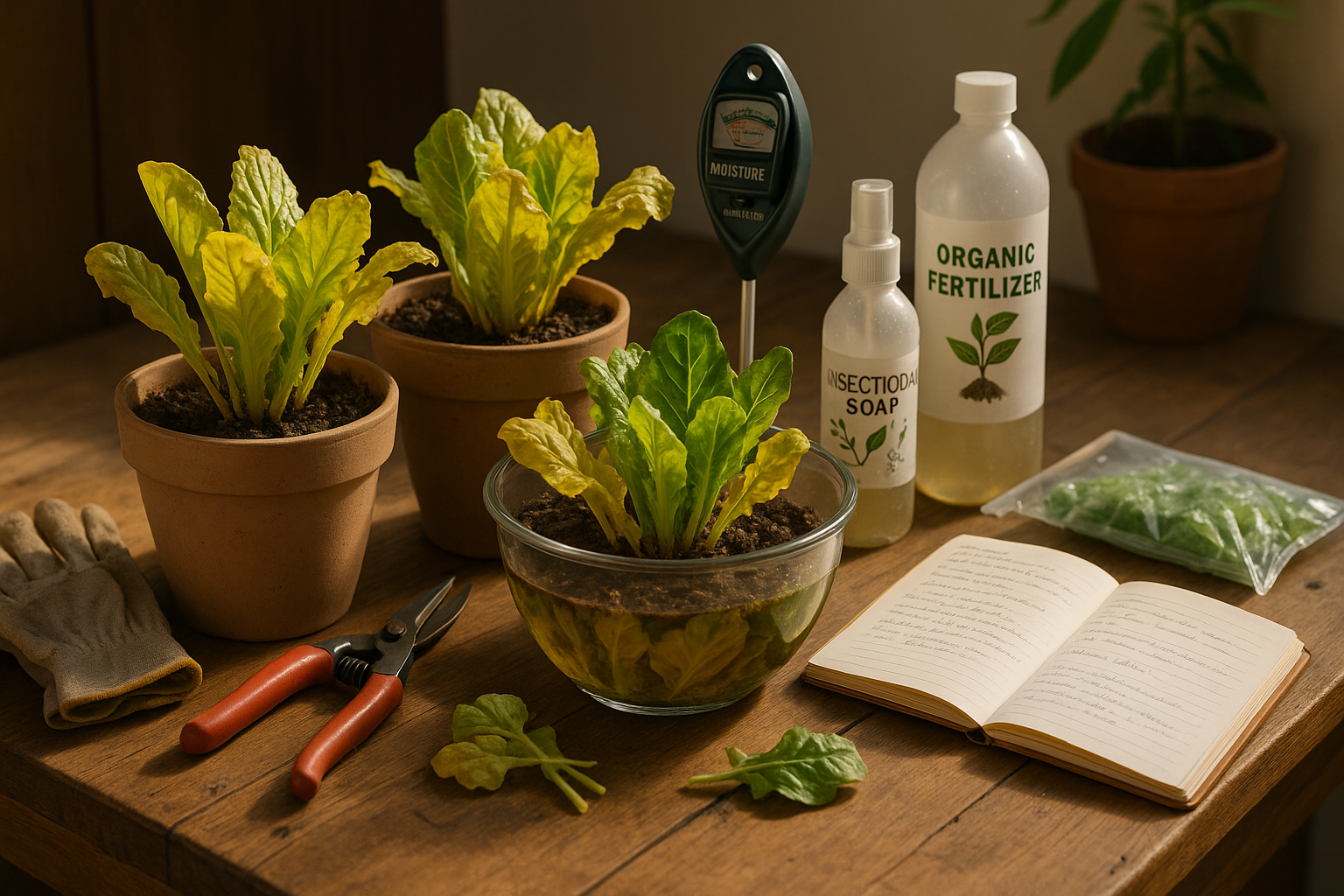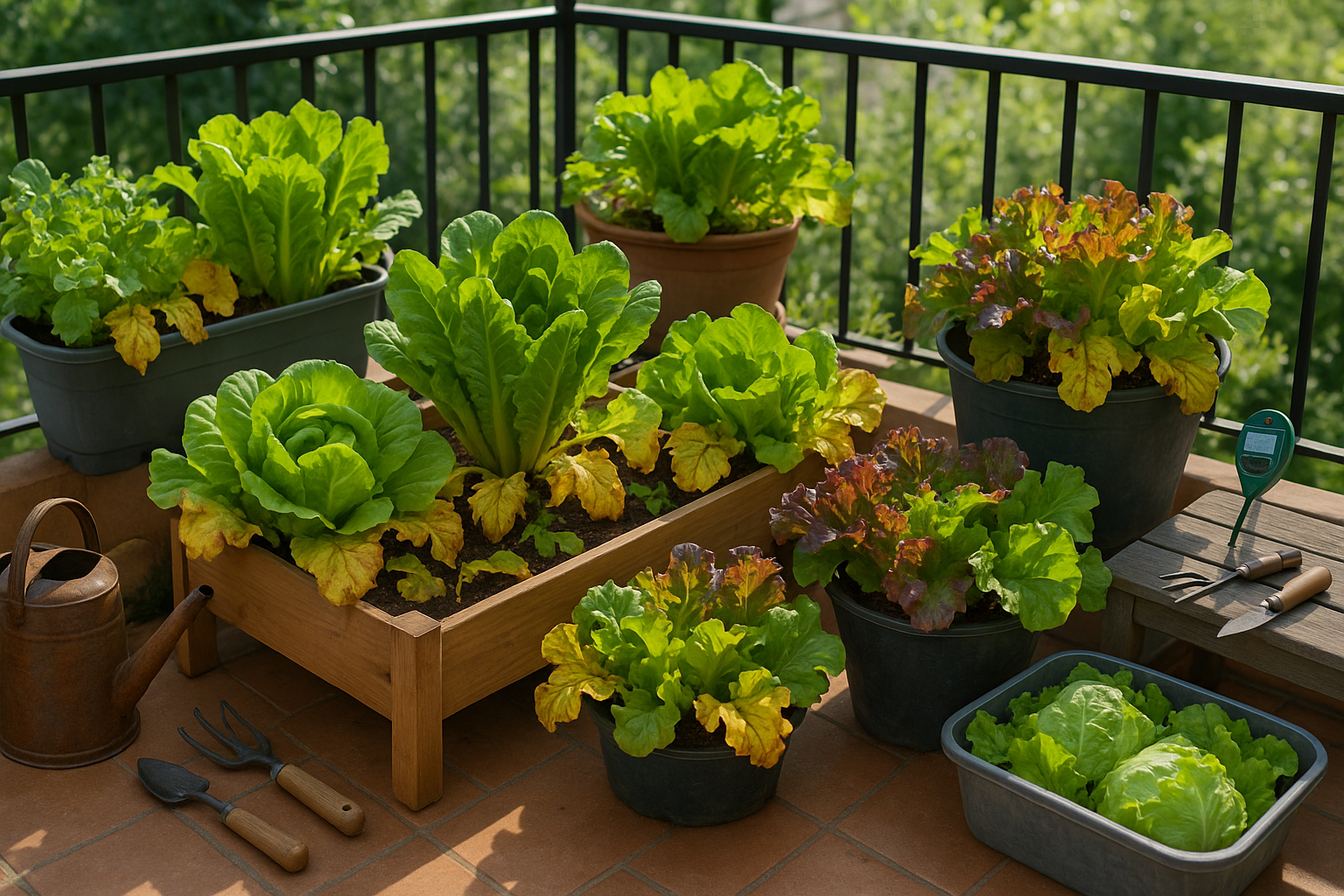Why Lettuce Leaves Turn Yellow
Yellow leaves on lettuce can be frustrating for any gardener, whether you’re growing your greens in containers on a balcony or directly in the ground. One of the most common culprits is water stress—both overwatering and underwatering can cause lettuce to lose its vibrant color. In containers, the soil dries out faster, so watch for wilting alongside yellowing as a sign to adjust your watering routine. In the ground, poor drainage can lead to root rot, especially after heavy rains, turning leaves yellow and mushy.
Nutrient deficiencies are another key factor, with a lack of nitrogen being the main suspect; this typically starts with older leaves turning pale before the rest of the plant follows. Regularly using a balanced, slow-release fertilizer can help prevent this, but be careful not to over-fertilize, which can burn roots.
Pests such as aphids and leaf miners, and diseases like downy mildew or fusarium wilt, are also common threats—look for distorted leaves, sticky residue, or spots as extra clues. Meanwhile, environmental stress from sudden temperature swings, especially with spring or fall plantings, can shock your lettuce, causing yellowing or even bolting.
When you spot yellow leaves, take a closer look: feel the soil moisture, inspect the leaf undersides for pests, and check the overall plant health. Correctly diagnosing the problem is vital because watering more won’t fix a pest issue, and spraying for bugs won’t help a nutrient shortage.
By paying attention to these details and adjusting care strategies accordingly, whether your lettuce is in pots or planted in beds, you’ll give it the best chance to stay crisp and green all season.
Water Woes

Both overwatering and underwatering can wreak havoc on lettuce. Though they may look similar at first, they cause very different problems. Overwatered lettuce usually shows yellowing, limp, and sometimes translucent leaves. The roots might become mushy or emit a sour odor—clear signs that root rot is setting in. On the other hand, underwatered lettuce wilts dramatically, with leaves crisping, browning at the edges, and often feeling dry to the touch.
Chronically stressed lettuce may bolt early or develop a bitter taste, making it unpalatable. To avoid these issues, it’s essential to check your soil moisture regularly before watering. Stick your finger about an inch into the soil near the base of the plant—if it feels dry, it’s time to water; if it’s still moist, hold off. For more accuracy, inexpensive moisture meters are widely available and can help take the guesswork out of your routine.
Aim to water deeply but less frequently, ensuring the soil stays consistently moist but not soggy. Morning is the best time to water, as it allows excess moisture to evaporate during the day, reducing the risk of fungal diseases. Mulching around your lettuce can also help regulate soil moisture and temperature.
Remember, lettuce has relatively shallow roots, so maintaining even, moderate moisture is key to preventing the problems caused by both underwatering and overwatering. With attentive observation and a consistent routine, you can keep your lettuce lush and thriving.
Nutrient Deficiencies and Imbalances
Lettuce thrives when supplied with a balanced mix of essential nutrients, and even a slight deficiency can quickly show up as yellowing leaves—a signal growers shouldn’t ignore. Nitrogen, one of the most critical nutrients, helps build lush, green foliage. When lettuce is low on nitrogen, its older outer leaves often turn pale yellow and look thin, sometimes stunted.
Magnesium is another key player; it’s vital for chlorophyll production. If magnesium is lacking, you’ll usually see yellowing between the veins of older leaves, while the veins themselves stay green—a telltale sign called interveinal chlorosis. Iron deficiency also causes yellowing, but this time it’s the young, new leaves that are most affected, appearing yellow with green veins.
To correct deficiencies, start by testing your soil to see exactly what’s missing. For nitrogen, applying a balanced fertilizer (like 10-10-10) or an organic source such as composted manure can help. Boost magnesium with Epsom salts (magnesium sulfate) diluted in water—spray directly onto leaves or water the soil. For iron, applying a chelated iron product is usually effective and fast-acting.
To prevent future problems, rotate crops, add organic matter to boost overall soil health, and avoid overwatering—too much water can wash nutrients away or make them unavailable to roots. Stick to a regular fertilizing schedule and pay close attention as your lettuce grows; catching yellow leaves early means you can step in before the problem spreads and ensure your greens stay crisp and vibrant.
Environmental and Cultural Stress Factors
Lettuce plants are particularly sensitive to environmental and cultural stress factors, which can quickly show up as yellowing leaves and stunted growth. Extreme sunlight, especially during hot afternoons, can scorch lettuce leaves and cause moisture to evaporate rapidly from both the soil and the plant. This stress often leads to wilting and even leaf burn.
Similarly, temperature fluctuations—such as chilly nights followed by hot days—can disrupt the plant’s natural rhythm, making it difficult for lettuce to absorb nutrients efficiently. Poor air circulation is another common issue, especially in dense beds or indoor setups, as stagnant air encourages humidity and fungal diseases that further weaken the plants.
How you space your lettuce also matters: crowding plants prevents air from moving between leaves, while wide spacing improves airflow and reduces competition for light and nutrients. Soil quality directly influences lettuce health as well; compacted or nutrient-poor soils limit root growth and water uptake, increasing the risk of yellowing leaves.
For best results, use a loose, well-draining soil rich in organic matter, and keep the soil consistently moist but not waterlogged. Provide afternoon shade—such as using shade cloths or planting in areas with partial sunlight during peak heat—to protect against scorching. To maintain steady temperatures and humidity, consider using mulch and avoid overhead watering to limit leaf wetness.
Routinely thin overcrowded seedlings and space mature plants about 6-8 inches apart for optimal air circulation and healthy growth. With these steps, you can create a thriving environment that helps your lettuce withstand environmental challenges.
Pest and Disease Troubles

Yellowing lettuce leaves often signal pest or disease problems, with aphids and slugs being the most common culprits. Aphids are tiny, soft-bodied insects that cluster on the undersides of leaves, sucking sap and leaving behind sticky residue and curled, yellowing foliage. Slugs, mostly active at night, chew irregular holes in lettuce leaves and leave shiny slime trails behind.
On the disease front, downy mildew and root rot are frequent threats. Downy mildew first appears as pale yellow patches on the tops of leaves, with fine grayish mold underneath—often spreading quickly in humid conditions. Root rot, usually caused by waterlogged soil, shows up as stunted growth, wilting, and yellow leaves. If you inspect the roots, they’ll appear brown and mushy instead of white and crisp.
Early detection is key to saving your crop, so check lettuce regularly for sticky residue, slimy trails, discolored patches, or limp leaves. For safe and effective management, start with physical removal:
- Rinse aphids off with a strong spray of water.
- Pick off slugs by hand in the evening.
Encourage natural predators like ladybugs in your garden to control aphids organically, and sprinkle diatomaceous earth around plants to deter slugs. For fungal diseases, water lettuce early in the morning so foliage dries quickly, and avoid wetting leaves when possible. Rotate crops and space plants well for better airflow. Remove and destroy any heavily infected plants to stop disease spread.
If problems persist, use organic treatments like neem oil for aphids or copper-based fungicides for mildew, but always read labels to ensure they’re safe for edible crops. In extreme cases, conventional pesticides or fungicides can be considered, but they should be a last resort due to potential impacts on beneficial insects and soil health. Regular monitoring and prompt intervention go a long way in keeping your lettuce beds healthy and productive.
Preventative Care
Keeping lettuce leaves healthy starts with adopting a proactive mindset—regular monitoring and early intervention are key to spotting and addressing issues before they spiral out of control. By checking your plants a few times each week, you can catch early signs of stress such as yellowing leaves, pest activity, or subtle fungal growth.
The moment you spot something unusual, take action: prune away affected leaves, adjust watering schedules, and, if needed, use organic pest controls. However, preventing problems before they appear is just as important.
Practice crop rotation by changing where you grow lettuce each season; this simple step disrupts the life cycles of soil-borne diseases and pests. Good garden hygiene is another crucial habit: clear away weeds, spent leaves, and any other debris that can harbor unwanted bugs or pathogens.
Consider companion planting—growing lettuce alongside beneficial plants like onions, marigolds, or herbs can naturally repel pests and promote healthier growth. Each of these strategies reduces stress on your lettuce and minimizes the odds of yellowing leaves caused by nutrient imbalance, overwatering, or disease.
Preventative care doesn’t just fix problems—it creates a thriving environment where your lettuce can flourish. An attentive, thoughtful approach throughout the growing season leads to resilient plants that produce tender, green leaves from first harvest all the way to the final picking.
By making these preventative practices part of your regular routine, you’ll spend less time troubleshooting and more time enjoying crisp, fresh salads straight from your garden.
Step-by-Step Action Plan to Revive Yellowing Lettuce

Reviving yellowing lettuce starts with careful observation. First, check the growing environment—yellow leaves often signal issues like overwatering, poor drainage, or lack of sunlight.
Gently inspect the soil: if it’s soggy, let it dry before the next watering, and consider switching to a well-draining potting mix. Ensure the plants get at least six hours of direct sunlight daily; move pots if needed.
Examine for pests such as aphids or slugs by looking under leaves and along stems; remove intruders by hand or use organic pest control.
Assess Nutrient Levels
Lettuce prefers steady, light feeding—apply a balanced, water-soluble fertilizer every two weeks, but avoid heavy doses that can burn roots. Remove yellow or wilted leaves with clean scissors to redirect energy to healthy growth.
Keep an eye out for crowded roots; if necessary, transplant to a larger container to give each plant room to thrive.
Maintain Regular Care
Make a habit of weekly check-ups, paying attention to leaf color and plant vigor. Adjust your care routine seasonally—reduce watering in cooler weather, and mulch in summer to conserve soil moisture.
Quick tip: water early in the day so leaves have time to dry, preventing fungal issues.
Over time, minor tweaks—like slightly rotating containers for even sunlight or keeping a gardening journal—can make a big difference. With consistent care and swift responses to stress signals, your lettuce will bounce back greener than ever and stay that way for future harvests.
